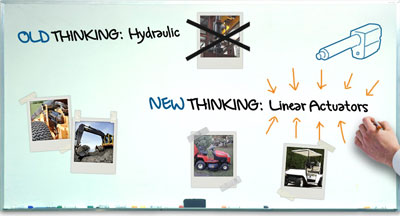If you’ve been reluctant to incorporate a linear actuator in a wide variety of industrial and mobile applications, you might think again. With a customized solution and step-by-step guidance from Thomson, you can realize significant value and performance benefits over hydraulic and pneumatic actuators.
With rugged and reliable operation, simple installation and lower costs, Thomson electric actuators are paving the way for significant control and productivity improvements in industrial equipment. Linear actuators provide superior control, improved reliability and, frequently, a lower cost solution.


By replacing hydraulic cylinders with electric actuators, you can eliminate pumps, hoses and valves as well as make the machinery smaller, lighter and quieter.
The benefits of electric actuators can be realized in applications with static loads up to 5000 lbs and dynamic loads up to 3000 lbs.
Electric linear actuators are specifically engineered to withstand harsh environments. Castings use finite element analysis to optimize their load handling capabilities. Electric actuator design has migrated from an approach that uses modular assemblies to one in which the key components are encapsulated in a clamshell that protects them against shock and vibration.


Thomson linear actuators prove themselves over and over in the long haul. Not only are they robust and durable, but they’re also a vast improvement over problematic hydraulics. Less maintenance means less downtime.
Maintenance with hydraulic systems begins with changing the fluid and filter on a regular basis and ensuring that the system always has sufficient fluid. Hydraulic fluid may be subject to contamination in some applications. Contamination causes a ripple effect as it moves through the system and damages multiple components, each of which may need to be repaired or replaced.
Today’s electric linear actuators require zero maintenance – not even lubrication. Electric linear actuators run independently with every axis being powered by a different motor, so a failure in an electric application affects only that single actuator which makes it much easier to troubleshoot and repair.
To ensure load hold, hydraulics require power to the system and should a hose or valve rupture its ability hold, the load is significantly compromised. Actuators, on the other hand, provide indefinite load holding in an un-powered condition, with virtually no drift or back driving. Finally, electric linear actuators can easily be configured with a manual override that can be used if something should go wrong with either the power supply or actuator motor.
Electric linear actuators are usually considerably less expensive in applications where an additional hydraulic pump must be added to handle another axis. As a general rule of thumb, when a hydraulic system operates one, two or three axes of motion, it can generally be replaced with electric linear actuators at a lower cost.
One linear actuator is faster and easier to install than multiple hydraulic components. It offers more accuracy, repeatability and a smooth, precise movement. It seamlessly interfaces with electronic controls and is programmable.
With a customized solution and a step-by-step guidance from Thomson, you can realize significant value and performance benefits over hydraulic and pneumatic actuators. Thomson experts will guide you through the largest range of standard and custom electric linear actuators on the market, so the process will be painless.
To learn more about linear actuators from Thomson, contact IBT.





